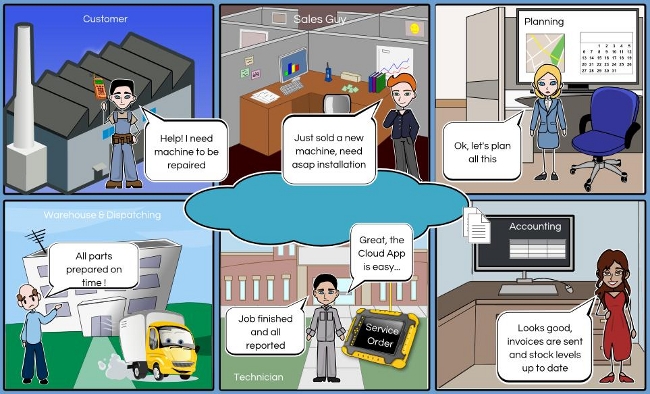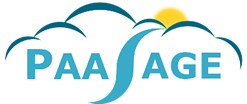ERP use case
By Franky Vanraes, be.wan IT Solutions
Organization behind the case
be.wan is an ICT Service company located in Belgium, delivering products and services in the domain of IT infrastructure, IP telephony, application development and consultancy. Sixty seven specialists, working on 3 locations, carry out ICT projects for a wide range of customers, mainly small and medium sized companies, but also local departments of multinational companies.
Products & Services
be.wan develops projects in the domain of :
- IT infrastructure : we advise, sell, install, implement, offer managed services… in the domain of hardware, such as servers, networks, security, hosting , workstations (PC’s), peripherals…
- Software : we advise, sell, customize, deliver, implement, give training & support… in the domain of ERP, Finance, Business Intelligence, Web Applications, Property Management, Office applications…
All our applications have been developed in-house and can be easily adapted in order to fulfill specific requirements from our customers.
Motivation for going to the cloud
The ability to offer the software in Cloud mode will allow be.wan to have a wider distribution of existing and new applications, and to approach new market segments previously unattainable. Compared to on-premise deployment and execution, the cloud-model offers also significant benefits in terms of high availability, elasticity, rapid on-boarding and worry-free exploitation and maintenance of infrastructure.
On top of that, PaaSage aims abstraction of cloud providers, so the software developer can concentrate on the development of the application and not on the deployment for specific clouds, based on requirements and constraints. The involvement of be.wan in the PaaSage project is a real opportunity to put its software portfolio one step ahead of its competitors.
Objectives
ERP – Use Case
One of the modules of a ERP system that can be very well designed as a cloud application is the "after sales service" module. The actors in the "after sales process" will be provided with an application that is accessible from different locations, using different devices, different client app’s, however sharing the same data & services. Availability, accessibility from anywhere and back office integration are key differentiators compared to existing manual or on premise systems.
In a after sales module, there are different actors ( human or machine ) :

- the customer requesting a service ( repair, maintenance ) and tracking the status
- the sales application, requesting a new installation
- the contract application, requesting recurrent maintenance tasks
- the machine itself, pushing data to the cloud ( Internet of Things )
- the planner, planning the execution of tasks
- the warehouse, preparing the necessary material and spare parts
- the field technician, travelling from the dispatching to the customers and executing the tasks and reporting spent time, used parts, etc.
- the accounting application, updating stock levels, producing the invoices, etc... once the job is finished
The actors need different applications running on, or accessible from different devices. The customer will probably use his pc/web browser to connect to the customer portal in order to request a service, or he will call the service desk to ask for a service. The planner will use a client application in order to plan the tasks and pass information to the warehouse. The technician will use a mobile application ( connected to the cloud ) to receive his tasks, inquire information about customers, contacts, machine history etc. and to enter data concerning the service task. After that, financial application services are needed to produce the invoices based on spent time and used material. ( or manufacturer claims ).
In a traditional system, many of the tasks in the process of the after sales department are done by phone, email and paper. A integrated system, highly available in the cloud and accessible anytime and from everywhere, will be far more efficient and will save a lot of work. In stead of calling, emailing, writing service reports on paper, re-entering data in the back office, etc. everything can be done by using the cloud applications. Spare parts can be ordered by using web services of manufacturers. Agenda’s can be shared. Technical documentation can be queried and Instant Messaging can be easily implemented. In case of unavailability of an internet connection, the technician can work offline and the cloud application can synchronize once the connection is back. In the near future, more and more machines will be connected directly to the cloud and will report in real time status, utilization, defects, etc… ( Internet of Things ). Without cloud ready applications, monitoring and analyzing this kind of data will be impossible.
For be.wan, such an application can be offered in a multi tenant SaaS model or in a Private cloud model, and PaaSage will be of great value as far as the deployment and execution decisions concerns.
As is
Current ERP applications are monolithic, not service oriented and developed using different fat-client / server technologies, they are license-based and run mostly on premises. Bringing such applications to the cloud, in a SaaS model is not possible. There is no support for multi-tenancy and SLA’s. There is no support for elastic scaling ( unless adding new hardware resources and expensive and time consuming re-deployments ). There is no support for mobile devices ( or other emerging UI’s ) on which the application can run on-line as well as off-line. There is no support for offering parts of the functionality to external users ( i.e. customer-portal for the customers of a facility services company ). And last but not least, support and maintenance of those applications requires a lot of effort because of the on-premise deployment model : many installations ( clients – servers ) on different infrastructure, different versions of OS, DBMS, VM etc. : just think about the time and effort it takes to release and roll out new features or bug fixes.
As Aimed ( To Be )
Multi tier and Service Oriented redevelopment of cloud-ready ERP applications and using PaaSage technology for cloud-deployment and execution decisions will be a solution for the problems mentioned above. PaaSage will reduce the complexity and improve the quality of deployment. Cloud computing is a more cost effective way of running applications : given the SLA, the goals, the constraints, the level of elasticity and the rules, PaaSage will propose the best possible deployment and execution platform. Application developers will not have to worry about deployment and execution, the loose coupling of application functionality and deployment/execution infrastructure will let developers concentrate on the application rather than on the infrastructure. Thanks to PaaSage, hybrid cloud deployment becomes also possible. One could think of storing data on a private cloud and executing application services on a public cloud in a “pay for what you use” model. The PaaSage methodology, the Service Oriented Architecture, the loose coupling of application layers and services will provide more flexibility and productivity in the development and rapid deployment of new applications and of tailor made client app’s, especially for be.wan’s SaaS model. PaaSage will also provide efficient resource allocation methods regarding the execution of those application services.

